Abstract
Introduction:
In Vietnam, the successful publication of research in indexed journals is mandatory to obtain academic appointments and promotions in medical colleges and institutions, according to the current guidelines established by the State Council for Professorship and Ministry of Education and Training.
Aim:
This study aimed to investigate the impacts of novel Vietnamese government regulations on radiological PhD and professorship candidates.
Methods:
This study evaluated freely accessible data, available online, and, therefore, did not require institutional review board approval. We assessed the numbers of radiological PhD candidates at Hanoi Medical University and the numbers of published Vietnamese radiological papers, from 2012 to 2019, indexed in the SCImago database. In addition, we evaluated the numbers of qualified radiological professors and associate professors employed at universities during the same period. We did not include nuclear medicine PhD and professorship candidates, in this study. The data are presented as bar and line charts.
Results:
Following the enactment of 08/2017/TT-BGDĐT and 37/2018/QĐ-TTg, we observed that the numbers of radiological PhD and professorship candidates were significantly reduced. From 2012 to 2019, only one candidate qualified for appointment as a radiological professor. However, the number of radiological papers rose dramatically during the same time period.
Conclusion:
The enactment of 08/2017/TT-BGDĐT and 37/2018/QĐ-TTg had strong impacts on the numbers of PhD and professorship candidates. Owing to these new regulations, the number of published, international, peer-reviewed radiological papers has increased; however, some undesired consequences may have occurred, such as papers being published in predatory or suspected predatory journals, double or triple submissions, and plagiarism.
Keywords: Novel Vietnamese government regulations, PhD, Professorship, Publications
1. INTRODUCTION
Many faculty members at medical colleges desire promotion to higher academic ranks, via PhD courses and professorship applications. Based on the “publish or perish” principle, the successful publication of research is a crucial prerequisite and primary criterion used to evaluate promotion possibilities. In Vietnam, scientific publications in peer-reviewed journals are compulsory for academic appointments and promotions at medical universities and institutions, in compliance with existing rules, established by the State Council for Professorship and the Ministry of Education and Training (1-4).
A PhD is the highest university degree that can be conferred by universities, in most countries. Doctoral degrees are awarded for programs across all academic fields. Because PhDs represent earned degrees in research, PhD students are generally required to produce original research that expands knowledge boundaries, usually in the form of a thesis or dissertation, and to defend their work against field experts. The basic criteria for obtaining a PhD degree can differ considerably from entry-level research degrees to higher doctorates, depending on the region, institution, and time span. A PhD candidate must submit a project, thesis, or dissertation, representing a body of original academic research, which is expected to be published in peer-reviewed journals (5-8). Vietnam, a non-English speaking nation, has begun to adopt standards for obtaining research doctorates that are similar to those that have been established for PhD degrees in Anglophone nations (3).
In most countries, a professor represents the highest academic level at universities and other post-secondary and research institutions. Typically, professors are specialists in their fields and are viewed as the top-ranking teachers. “Professor” refers only to the highest academic position in many academic ranking systems, a position that is sometimes referred to as “full professor”. In some countries and institutions, the word “professor” is also used in lower-ranking titles, such as associate professor and assistant professor. The specific requirements for obtaining a professorship vary considerably, depending on the country, institution, and time period, ranging from research degrees at the entrance level to higher doctorates (5-11). However, successfully obtaining a professorship requires that studies be published in peer-reviewed journals (1, 4, 5-11).
In Vietnam, according to 174/2008/QĐ-TTg, which was enacted in 2008 (1), and 10/2009/TT-BGDĐT, which was enacted in 2009 (2), PhD and professorship candidates were not required to publish their studies on international peer-reviewed journals. However, in keeping with current global trends, the Vietnamese government changed these regulations when they enacted 08/2017/TT-BGDĐT, in 2017 (3), and 37/2018/QĐ-TTg, in 2018 (4), which required both PhD and professorship candidates to publish their papers in international, peer-reviewed journals.
2. AIM
Hence, we conducted this study to investigate the impacts of these novel Vietnamese government regulations (08/2017/TT-BGDĐT and 37/2018/QĐ-TTg) on radiological PhD and professorship candidates.
3. MATERIAL AND METHODS
This study assessed data that is publicly available online; therefore, institutional review board approval was not required. We assessed the number of radiological PhD candidates in Hanoi Medical University and the number of published Vietnamese radiological papers indexed in the SCImago database, from 2012 to 2019. In addition, we also evaluated the number of qualified radiological professors and associate professors who were appointed during this period. We did not include nuclear medicine PhD and professorship candidates in this study.
The SPSS version 26.0 (IBM Corp., Armonk, New York, USA) was utilized for statistical descriptions. The data are presented as bar and line charts.
4. RESULTS
As shown in Figure 1, the numbers of medical PhD candidates in 2012, 2013, 2014, 2015, 2016, 2017, 2018, and 2019 were 98, 143, 118, 118, 130, 26, 34, and 25, respectively, whereas the numbers of radiological PhD candidates were 6, 5, 6, 1, 4, 0, 0, and 2, respectively.
Figure 1. Line chart displaying the numbers of radiological PhD candidates, from 2012 to 2019, at Hanoi Medical University.
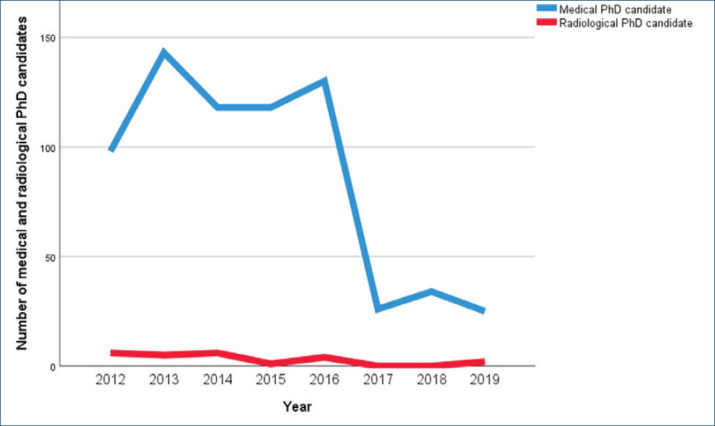
As shown in Figure 2, the numbers of medical associate professors during 2012, 2013, 2014, 2015, 2016, 2017, and 2019 were 86, 75, 95, 66, 114, 153, and 27, respectively, whereas numbers of medical professors were 10, 13, 17, 9, 7, 16, and 8, respectively.
Figure 2. Line chart showing the numbers of medical professors and associate professors, from 2012 to 2019.
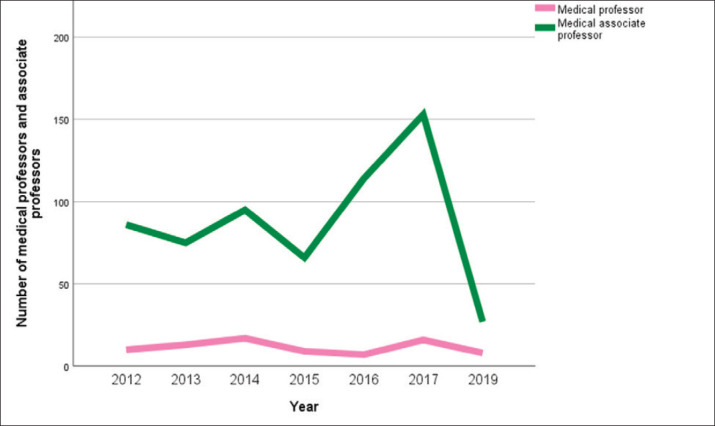
As shown in Figure 3, no radiological professors were appointed from 2013 to 2019, and only one professor was appointed in 2012 (Figure 4). The numbers of radiological associate professors appointed in 2012, 2013, 2014, 2015, 2016, 2017, and 2019 were 1, 1, 1, 1, 4, 4, and 1, respectively.
Figure 3. Bar chart showing the numbers of radiological professors and associate professors, from 2012 to 2019.
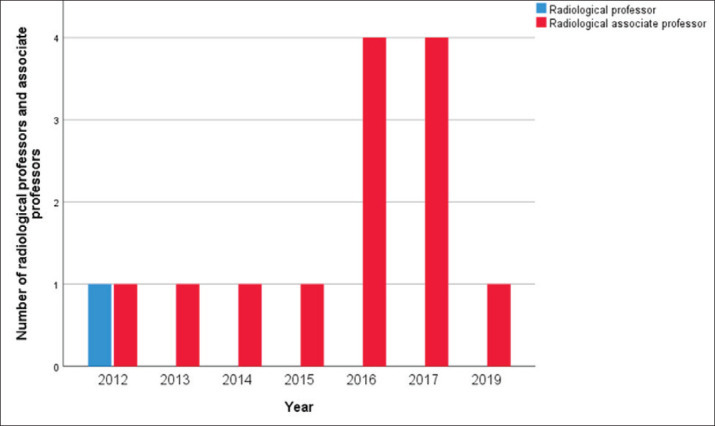
Figure 4. Dr. Pham Minh Thong, who qualified as a radiological professor in 2012, currently serves as the president of both the Vietnamese Society of Radiology and Nuclear Medicine and the Vietnamese Society of Interventional Radiology (9,10).
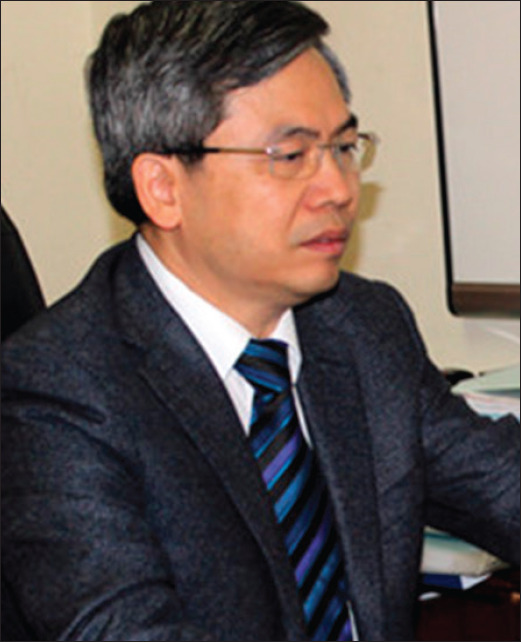
As shown in Figure 5, the numbers of Vietnamese medical papers published in 2012, 2013, 2014, 2015, 2016, 2017, 2018, and 2019 were 533, 591, 618, 732, 837, 1085, 1365, and 1923, respectively.
Figure 5. Bar chart displaying the numbers of medical papers, published from 2012 to 2019.
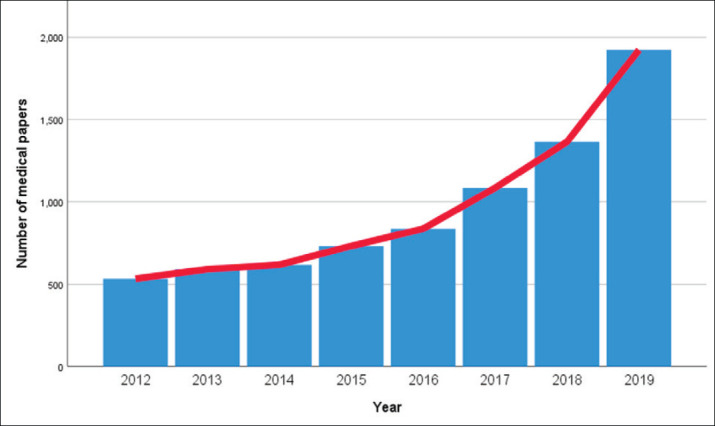
As shown in Figure 6, the numbers of radiological papers published in 2012, 2013, 2014, 2015, 2016, 2017, 2018, and 2019 were 14, 14, 16, 17, 14, 32, 46, and 73, respectively.
Figure 6. Line chart showing the numbers of radiological papers published from 2012 to 2019.
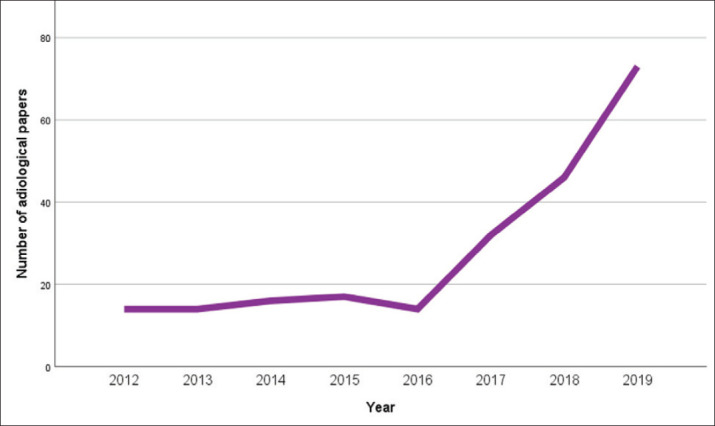
5. DISCUSSION
Overall, after 08/2017/TT-BGDĐT (3) and 37/2018/QĐ-TTg (4) were issued, we observed that the numbers of medical PhD and professorship candidates in radiological subjects were significantly reduced. Between 2012 and 2019, only one candidate qualified as a radiological professor. However, the numbers of published Vietnamese medical papers, including radiological papers, increased substantially during this time period.
According to 10/2009/TT-BGDĐT, prior to defending a PhD thesis against experts in the field, PhD candidates were required to publish at least 2 papers related to the thesis subject in domestic, peer-reviewed journals (2, 7). Starting in 2017, with the enactment of 08/2017/TT-BGDĐT, PhD candidates were required to publish at least one paper related to the thesis subject in a peer-reviewed journal that is indexed by Scopus and/or Web of Science (WoS) or two papers related to the thesis subject in international, peer-reviewed journals (3, 7). According to 174/2008/QĐ-TTg, professor and associate professor candidates were not required to publish their work in international, peer-reviewed journals (1); however, the enactment of 37/2018/QĐ-TTg (4) in 2018 required both professor and associate professor candidates to publish their research in journals indexed by Scopus and WoS. These requirements logically enhanced the number of published radiological papers notably (3, 7, 9-12).
Although these new rules represent a serious effort to encourage science, they also have the potential to generate many problems, fueling the growth of fraudulent journals, transgressions in scientific communication, the evolution of manuscript writing services, reductions in the quality of academic publications, and a competitive race for publications. (13, 14). The workflow utilized by the native-English-speaking scientific journals that are indexed by Scopus and WoS is foreign to many Vietnamese radiological PhD and professorship candidates (14, 15). Low-quality work is often conducted and documented in developing countries for a variety of reasons, including the lack of critical funding, poor and outdated infrastructure, and restricted access to current references (15-18). Furthermore, some radiological PhD and professorship candidates are not-well qualified in research methods, lack sufficient time to perform research, and are deficient in academic English grammar. Research performed by Vietnamese PhD and professorship candidates is, therefore, often not accepted for publication in good journals. The repeated submission of manuscripts, resubmissions, and rejections can be extremely painful for authors. The long review processes associated with many journals can also increase the anxiety and tension of research teams (19-21). We hypothesize that these factors have contributed to a substantial reduction in the numbers of applicants for radiological doctorates and professorships.
Additionally, an undesirable effect of these new regulations has been that some authors become victims of predatory journals (22-26). The greatest number of predatory journals and publishers appear to be based in India (22-24). Predatory publication practices are a likely manifestation of the “publish or perish” trend, with writers eager to pay for publications and hesitant to engage with the authentic peer-reviewed journals that are indexed by Scopus and WoS (25-28). Predatory journals are widely acknowledged to have corrupted the world of scientific publications. They charge publishing fees but omit the peer review process. Newly launched journals that embrace the concept of gold open access have a much greater interest in accepting all submissions during a short time, without a robust peer review phase (22-31). Peer review continues to represent the best method for ensuring the quality of scientific material (27-29). A decline in peer review standards will result in a decline in the quality of scientific journals, providing substandard articles with easy access to publication (26-31). Recently, some submitted papers from Vietnam, with high similarity indexes, have been ineffectively prepared, according to a report by Izet Masic (32). Most likely, several Vietnamese authors, to increase the probability of publication, simultaneously submitted one paper to two or three journals, which highlights the ethical problems that exist, worldwide (32, 33). To successfully obtain publications, some unqualified Vietnamese radiological authors have attempted to obtain authorship in Scopus- or WoS-indexed journals unrelated to radiology or have relied on qualified authors in different fields, who serve as the corresponding author for their papers. A new phenomenon has also been observed, in which Vietnamese radiological authors planned to publish massively in near-ended Scopus or Emerging Sources Citation Index journals, aiming to accumulate points to cope with the new regulations.
In light of these troublesome conditions, the State Council for Professorship encourages applicants to publish their articles in Scopus- and/or WoS-indexed journals that are relevant to their particular fields, supported by reputable publishers such as Springer, Elsevier, SAGE Publishing, Wiley, Taylor & Francis, Highwire Press, Wolters Kluwer, De Gruyter, Thieme, etc (34). We recommend that Vietnamese radiological researchers review and carefully follow the guidelines established by the Committee on Publication Ethics (COPE), the recommendations of the International Committee of Medical Journal Editors (IJCME), and the guidelines established by the State Council for Professorship when attempting to publish papers in prestigious journals that are indexed by the WoS and/or Scopus. We also suggest that Vietnamese radiological authors should cease publishing in fake journals (4, 34-42).
This study has several limitations. First, the study period was limited, and the full effects of these new legislations on the study subjects could not be determined. Second, the retrospective study design limits the ability to determine causal relationships. Single-nation data were introduced only as charts, which lack comparisons against other nations. We propose that further study should be undertaken, contrasting the data for Vietnam with data from multiple nations, to determine the full impacts of novel regulations on international publications, PhD candidates, and professorship applicants.
6. CONCLUSION
The enactment of 08/2017/TT-BGDĐT and 37/2018/QĐ-TTg greatly affected the number of applicants for PhD and professorship. Owing to new regulations, the number of international peer-reviewed radiological papers has accelerated energetically; however, certain undesired events occur, such as papers published in predatory or suspiciously predatory journals, double or triple submissions, and plagiarism.
Acknowledgment:
The authors would like to thank the State Council for Professorship and Ministry of Education and Training owing to their general support and technical help.
Ethical approval and Declaration of patient consent:
Not applicable.
Author’s contribution:
Nguyen Minh Duc gave a substantial contribution in acquisition, analysis, and data interpretation. Each author had a part in preparing article for drafting and revising it critically for important intellectual content. Each author gave the final approval of the version to be published and agreed to be accountable for all aspects of the work, ensuring that questions related to the accuracy or integrity of any part of the work are appropriately investigated and resolved.
Conflicts of interest:
There are no conflicts of interest to declare.
Financial support and sponsorship:
Nil.
REFERENCES
- 1.Quyết định số 174/2008/QĐ-TTg của Thủ tướng Chính phủ: Ban hành Quy định tiêu chuẩn, thủ tục bổ nhiệm, miễn nhiệmchức danh giáo sư, phó giáo sư [Internet] 2008. [29 June 2020]. Available via https://thuvienphapluat.vn/van-ban/giao-duc/Quyet-dinh-174-2008-QD-TTg-Quy-dinh-tieu-chuan-thu-tuc-bo-nhiem-miennhiem-chuc-danh-giao-su-pho-giao-su-83451.aspx.
- 2.Thông tư 10/2009/TT-BGDĐT ban hành quy chế đào tạo trình độ tiến sĩ do bộ giáo dục và đào tạo ban hành [Internet] 2009. [29 June 2020]. Available via https://thuvienphapluat.vn/van-ban/giao-duc/Thong-tu-10-2009-TT-BGDDT-quy-che-dao-tao-trinh-dotien-si-88568.aspx.
- 3.Thông tư 08/2017/TT-BGDĐT quy chế tuyển sinh và đào tạo trình độ tiến sĩ do bộ trưởng bộ giáo dục và đào tạo ban hành [Internet] 2017. [29 June 2020]. Available via https://thuvienphapluat.vn/van-ban/giao-duc/Thong-tu-08-2017-TT-BGDDT-Quy-che-tuyen-sinhdao-tao-trinh-do-tien-si-338487.aspx.
- 4.Quyết định số 37/2018/QĐ-TTg của Thủ tướng Chính phủ: Ban hành quy định tiêu chuẩn, thủ tục xét công nhận đạt tiêu chuẩn và bổ nhiệm chức danh giáo sư, phó giáo sư; thủ tục xét hủy bỏ công nhận chức danh và miễn nhiệm chức danh giáo sư, phó giáo sư [Internet] 2018. [29 June 2020]. Available via https://thuvienphapluat.vn/van-ban/giao-duc/Quyet-dinh-37-2018-QD-TTg-thu-tucxet-cong-nhan-dat-tieu-chuan-va-bo-nhiem-giao-su-phogiao-su-394211.aspx.
- 5.Dinham S, Scott C. The Experience of Disseminating the Results of Doctoral Research. Journal of Further and Higher Education. 2001;25(1):45–55. [Google Scholar]
- 6.Fan AP, Tran DT, Kosik RO, Mandell GA, Hsu HS, Chen YS. Medical education in Vietnam. Med Teacher. 2012;34(2):103–107. doi: 10.3109/0142159X.2011.613499. [DOI] [PubMed] [Google Scholar]
- 7.Duc NM, Huy HQ, Keserci B, Thong PM. A Preliminary Vietnamese Comparative Study of Postgraduate Radiological Thesis Characteristics. Med Arch. 2020;74(1):42–46. doi: 10.5455/medarh.2020.74.42-46. [DOI] [PMC free article] [PubMed] [Google Scholar]
- 8.Barnett JV, Harris RA, Mulvany MJ. A comparison of best practices for doctoral training in Europe and North America. FEBS Open Bio. 2017;7(10):1444–1452. doi: 10.1002/2211-5463.12305. [DOI] [PMC free article] [PubMed] [Google Scholar]
- 9.Duc NM, Huy HQ, Thong PM. Vietnamese Society of Radiology and Nuclear Medicine: Past, Current and Future. Acta Inform Med. 2019;27(5):374–379. doi: 10.5455/aim.2019.27.374-379. [DOI] [PMC free article] [PubMed] [Google Scholar]
- 10.Duc NM, Ha HD, Thong PM. An Overview of Vietnamese Society of Interventional Radiology. Med Arch. 2020;74(3):224–227. doi: 10.5455/medarh.2020.74.224-227. [DOI] [PMC free article] [PubMed] [Google Scholar]
- 11.Duc NM, Huy HQ, Keserci B, Thong PM. Gender Disparity in Vietnamese Radiological Societies: a Preliminary Observational Study. Acta Inform Med. 2020;28(1):71–74. doi: 10.5455/aim.2019.28.71-74. [DOI] [PMC free article] [PubMed] [Google Scholar]
- 12.SIR Ranking of Viet Nam [Internet] 2020. [29 June 2020]. Available via https://www.scimagojr.com/countrysearch.php?country=VN.
- 13.Banerjee A. The publication rat race: Who will bell the cat? Med J DY Patil Univ. 2013;6:219–220. [Google Scholar]
- 14.Masic I. How to search, write, prepare and publish the scientific papers in the biomedical journals. Acta Inform Med. 2011;19(2):68–79. doi: 10.5455/aim.2011.19.68-79. [DOI] [PMC free article] [PubMed] [Google Scholar]
- 15.Masic I. Ethical aspects and dilemmas of preparing, writing and publishing of the scientific papers in the biomedical journals. Acta Inform Med. 2012;20(3):141–148. doi: 10.5455/aim.2012.20.141-148. [DOI] [PMC free article] [PubMed] [Google Scholar]
- 16.Langer A, Díaz-Olavarrieta C, Berdichevsky K, Villar J. Why is research from developing countries underrepresented in international health literature, and what can be done about it?; Bull World Health Organ; 2004. pp. 802–803. [PMC free article] [PubMed] [Google Scholar]
- 17.Siriwardhana C. Promotion and reporting of research from resource-limited settings. Infect Dis (Auckl) 2015;8:25–29. doi: 10.4137/IDRT.S16195. [DOI] [PMC free article] [PubMed] [Google Scholar]
- 18.Peh W. Scientific writing and publishing: Its importance to radiologists. Biomed Imaging Interv J. 2007;3:e55. doi: 10.2349/biij.3.3.e55. [DOI] [PMC free article] [PubMed] [Google Scholar]
- 19.Sukhlecha A. Research publications: Should they be mandatory for promotions of medical teachers? J Pharmacol Pharmacother. 2011;2(4):221–224. doi: 10.4103/0976-500X.85929. [DOI] [PMC free article] [PubMed] [Google Scholar]
- 20.Aggarwal R, Gogtay N, Kumar R, Sahni P. Indian Association of Medical Journal Editors. The revised guidelines of the Medical Council of India for academic promotions: Need for a rethink. Indian J Anaesth. 2016;60:1–5. doi: 10.4103/0019-5049.174800. [DOI] [PMC free article] [PubMed] [Google Scholar]
- 21.Kurdi MS, Ramaswamy AH, Lokare L, Sutagatti JG. Current views and practice of faculty members and consultants regarding “Publications in India”: A cross-sectional study. Indian J Anaesth. 2015;59:794–800. doi: 10.4103/0019-5049.171567. [DOI] [PMC free article] [PubMed] [Google Scholar]
- 22.Shen C, Björk BC. ‘Predatory’ open access: a longitudinal study of article volumes and market characteristics. BMC Med. 2015;13:230. doi: 10.1186/s12916-015-0469-2. [DOI] [PMC free article] [PubMed] [Google Scholar]
- 23.Masic I. Predatory Publishing–Experience with OMICS International. Med Arch. 2017;71(5):304–307. doi: 10.5455/medarh.2017.71.304-307. [DOI] [PMC free article] [PubMed] [Google Scholar]
- 24.BEALL’S LIST OF POTENTIAL PREDATORY JOURNALS AND PUBLISHERS [Internet] 2020. [29 June 2020]. Available via https://beallslist.net/
- 25.Beall J. Predatory publishers are corrupting open access. Nature. 2012;489:179. doi: 10.1038/489179a. [DOI] [PubMed] [Google Scholar]
- 26.Conn VS. Paying the price for open access. West J Nurs Res. 2015;37:3–5. doi: 10.1177/0193945914554257. [DOI] [PubMed] [Google Scholar]
- 27.Kurdi MS. “Scholarly peer reviewing”: The art, its joys and woes. Indian J Anaesth. 2015;59:465–470. doi: 10.4103/0019-5049.162981. [DOI] [PMC free article] [PubMed] [Google Scholar]
- 28.Bohannon J. Who’s afraid of peer review? Science. 2013;342(6154):60–65. doi: 10.1126/science.2013.342.6154.342_60. [DOI] [PubMed] [Google Scholar]
- 29.Masic I. Peer Review–Essential for Article and Journal Scientific Assessment and Validity. Med Arch. 2016;70(3):168–171. doi: 10.5455/medarh.2016.70.168-171. [DOI] [PMC free article] [PubMed] [Google Scholar]
- 30.Richtig G, Berger M, Lange-Asschenfeldt B, Aberer W, Richtig E. Problems and challenges of predatory journals. J Eur Acad Dermatol Venereol. 2018;32(9):1441–1449. doi: 10.1111/jdv.15039. [DOI] [PMC free article] [PubMed] [Google Scholar]
- 31.Weiss A, Lambert WC, Parish LC. Predatory Journals: Harmful to Patients, the Public, and the Integrity of Scientific Research. Skinmed. 2017;15(3):167–168. [PubMed] [Google Scholar]
- 32.Masic I. Unethical Behaviors of Authors Who Published Papers in the Biomedical Journals Became a Global Problem. Med Arch. 2020;74(1):4–7. doi: 10.5455/medarh.2020.74.4-7. [DOI] [PMC free article] [PubMed] [Google Scholar]
- 33.Masic I. Plagiarism in scientific publishing. Acta Inform Med. 2012;20(4):208–213. doi: 10.5455/aim.2012.20.208-213. [DOI] [PMC free article] [PubMed] [Google Scholar]
- 34.Quyết định phê duyệt Danh mục tạp chí khoa học được tính điểm năm 2020 [Internet] 2020. [29 June 2020]. Available via http://hdgsnn.gov.vn/tin-tuc/quyet-dinh-phe-duyet-danh-muc-tap-chi-khoa-hocduoc-tinh-diem-nam-2020_538/
- 35.Committee on Publication Ethics (COPE) GUIDELINES ON GOOD PUBLICATION PRACTICE [Internet] 2020. [29 June 2020]. Available via http://publicationethics.org/files/u7141/1999pdf13.pdf.
- 36.The recommendations for the Conduct, Reporting, Editing, and Publication of Scholarly work in Medical Journals Internet] 2020. [29 June 2020]. Available via http://www.icmje.org/recommendations/ [PubMed]
- 37.Scopus [Internet] 2020. [29 June 2020]. Available via https://www.scopus.com/sources.uri.
- 38.Web of Science [Internet] 2020. [29 June 2020]. Available via https://mjl.clarivate.com/home.
- 39.Beall J. Dangerous Predatory Publishers Threaten Medical Research. J Korean Med Sci. 2016;31(10):1511–1513. doi: 10.3346/jkms.2016.31.10.1511. [DOI] [PMC free article] [PubMed] [Google Scholar]
- 40.Das S, Chatterjee SS. Cabell’s Blacklist: A New Way to Tackle Predatory Journals. Indian J Psychol Med. 2018;40(2):197–198. doi: 10.4103/IJPSYM.IJPSYM_290_17. [DOI] [PMC free article] [PubMed] [Google Scholar]
- 41.Beall J. Best practices for scholarly authors in the age of predatory journals. Ann R Coll Surg Engl. 2016;98(2):77–79. doi: 10.1308/rcsann.2016.0056. [DOI] [PMC free article] [PubMed] [Google Scholar]
- 42.Beall J. Predatory journals: Ban predators from the scientific record. Nature. 2016;534(7607):326. doi: 10.1038/534326a. [DOI] [PubMed] [Google Scholar]


